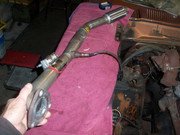Revisit our earlier discussion.
viewtopic.php?f=22&t=80234&p=622717#p622717
TO3B's were sold in five cars from 1979 to 1982, the 4.9 Firebird TA Turbo, 3.8 T type Rivera and Regal, the 2.3 carb turbo Ford Mustang and Mercury Capri.
130,000 from 79 to 82.
With parts back-up. 20 dollars for O rings, 24 dollars for Combustion seals.
"http://vb.foureyedpride.com/showthread.php?92600-Carb-Turbo-M81-Mclaren-ready-to-start-after-15-years!/page10"
m81mclaren":1mx39kad said:
G-Pop Shop delivered and looks beautiful! Picked up the FelPro o-ring kit and now the last item to source is the gasket for the hot side manifold that I didn't need to split open in the first place:fp:
Does anyone know where to source this last piece that goes between the hot side housing to exhaust manifold?
https://gpopshop.com/garrett-kits.html
Find two Ford 2.3 carb turbos and put two Buick or Pontiac intakes on them. And two turbos on that log with two Dual Jet carbs. One 2bbl direct mont hole gets fed by one turbo in the stock position Powerband used. And another turbo and intake forward, with its feeder to the direct mount intake reversed.
Use a Strip Dominator 400 hp Chevy diaphragm fuel pump which makes in excess of 10.5 psi fuel pressure. And set the turbos to 7 psi. Use an Aeromotive or Malpassi boost fuel pressure regulator. Full boost, 10.5 -12.5 psi fuel pressure. Idle and part throttle no boost, 7 psi.
The old Olds 262 or 307 or Pontiac 301 Dual Jets have a small primary 2bbl, about 1.16s, with simple metering rods for 110 to 130 hp each, but able to supply 315 hp net if the metering rods and jetting is adequate. Fuel pressure must be adequate.
Its VERY important to know Why and What you need TO3B turbos for. In the Triple K/Schwitzer/ Rotomaster/Garret turbo OEM supply wars in supplier info from 1976 to 1984, the information was insufficient from the supplier to help the back yard conversion industry. The Draw through wasnt bad technology...it was killed off by the electronic Fuel Injection. When the 1976 Cadillac Seville and the one Oldsmobile released the EFI 350 gasoline engine, and the engineer for the Carb turbo Mustang said it was going EFi fir the next turbo install, draw throughs got killed off. Best induction system for draw through us programmed electronic Fuel Injection. Two CFi 3.8 or 5.0 Ford fuel injection throttke bodies. They are able to be run off any MegaSquirt system. Stock 2 bar map sensor and an F250 electric fuel pump and your into a midern draw through. But it has to be twin turbo to feed both legs of the log evenly.
Draw throughs are an art form. Ak Millers 1972-73 Pangra (Pinto 2.0 based) was draw through. Ak Millers 250 Maverick used a draw through gasoline engine with 4bbl carb feeding the single 1.75 inch log intake in 1977, but he wasnt allowed to fit twin carbs on a California car.
His Propane turbos were always blow through. Any emerging US EFi engine used blow through technology.
The gap in bolt on turbos was draw through. Huge MacInnes prevented any great information being circulated on TO3 and TO4 turbo draw throughs because he was a Rotomaster engineer. No disrespect for his work was exceptional. But we all work for The Man, and even in the 2nd Turbocharging book revision by Hugh, draw throughs were going out of fashion...Fast!























 was only focusing on the single piston in the thumbnail picture. :rolflmao: I guess I am getting blinder everyday. Mahile (German company I think probably spelled it wrong too) but their also making some great pistons to.
was only focusing on the single piston in the thumbnail picture. :rolflmao: I guess I am getting blinder everyday. Mahile (German company I think probably spelled it wrong too) but their also making some great pistons to. 


























